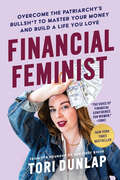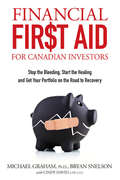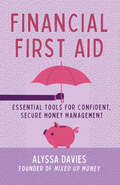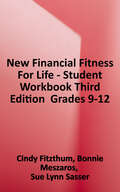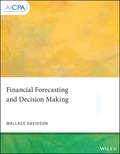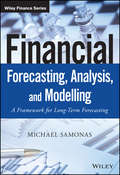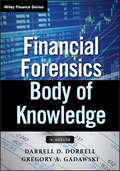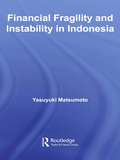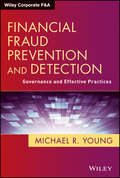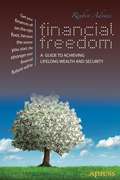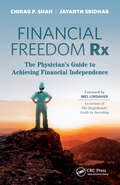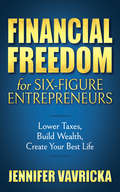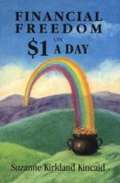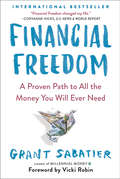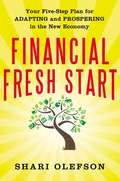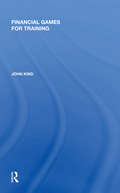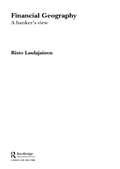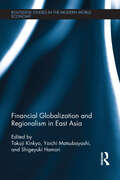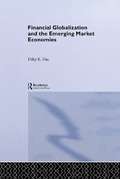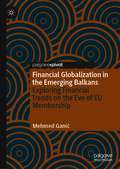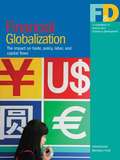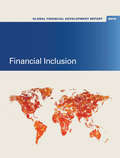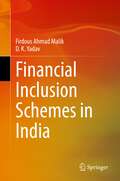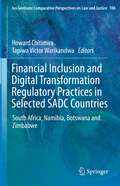- Table View
- List View
Financial Feminist: Overcome the Patriarchy's Bullsh*t to Master Your Money and Build a Life You Love
by Tori DunlapFinancial Feminist has descriptive copy which is not yet available from the Publisher.
Financial First Aid for Canadian Investors: Stop the Bleeding, Start the Healing and Get Your Portfolio on the Road to Recovery
by Michael Graham Bryan Snelson Cindy DavidPraise for the previous edition, Portfolio First Aid "I'd categorize Portfolio First Aid as a serious investment primer that has the laudable, if ambitious, goal of raising the sophistication level of the general public." —Jonathan Chevreau, Financial Post "Portfolio First Aid has the right pedigree as an advice tome on healthy investing. Covers the bases of portfolio balance, building wealth, investing for income and managing risk." —The Edmonton Journal The financial meltdown has taken a severe toll on the finances of Canadians, and on their confidence in financial and investment advisors. Canadians need help to learn how to diagnose what is the greatest threat to their long-term financial well-being and to follow a course of treatment to recovery. Financial First Aid for Canadian Investors is for all the battered and bloodied investors whose portfolios are in tatters and who lack direction about what to do next. By examining the lessons to be learned from mistakes made in both good and bad markets, the authors address the common and recurring investment blunders they have witnessed over many years, and offer a clear prescription for how to repair wounded portfolios.
Financial First Aid: Essential Tools for Confident, Secure Money Management
by Alyssa DaviesA practical guide for handling life's financial emergencies for the cash-strapped, the meticulous budgeter, and everyone in between. What do a layoff, a medical emergency, a broken appliance, and a natural disaster have in common? Each scenario has the potential to upend your personal finances, no matter your financial situation. Money can be an intense source of stress, especially when you suddenly don't have enough of it. This handy and accessible reference from Alyssa Davies, founder of the popular finance blog Mixed Up Money, is here to help you navigate these financial ups and downs with a judgment-free approach. It offers actionable advice for different types of emergencies, short- and long-term solutions, resources, and tips from well-known financial experts who have been there before. You'll find scripts for negotiating payments for large bills, and learn how to revise a budget if you need to care for a loved one who is sick, recognize financial abuse, and much more. Charming illustrations by the author add a touch of humor to her expert advice. Best practices for building a robust emergency fund and road maps for recovering from a financial emergency will help you face your next rainy day.
Financial Fitness for Life Student Workbook, Grades 9-12
by Bonnie Meszaros Scott Bacon Gail Colbert Cindy Fitzthum Sue Lynn SasserThis book is a CEE publication that helps teachers prepare students for life beyond the classroom by presenting materials based on real-world concepts in a way that reinforces learning through practice. The lesson plans within this collection have a description of the lesson, slides, and/or activities with educational technology tools such as Kahoot! and/or Quizlet. For full access to the book, shop for the Teacher Guide and Student Workbook.
Financial Forecasting and Decision Making (AICPA)
by Wallace Davidson IIIMany companies fail to succeed due to poor planning, which is one reason why CPA's are in big demand. Skilled at forecasting, CPAs can plan a company's future by determining the maximum sustainable growth and predict its external fund requirements. This course provides you with the basic tools necessary to project the balance sheet and statements of income and cash flow, enabling you to add a unique value to your client(s) work.
Financial Forecasting, Analysis and Modelling
by Michael SamonasRisk analysis has become critical to modern financial planningFinancial Forecasting, Analysis and Modelling provides a complete framework of long-term financial forecasts in a practical and accessible way, helping finance professionals include uncertainty in their planning and budgeting process. With thorough coverage of financial statement simulation models and clear, concise implementation instruction, this book guides readers step-by-step through the entire projection plan development process. Readers learn the tools, techniques, and special considerations that increase accuracy and smooth the workflow, and develop a more robust analysis process that improves financial strategy. The companion website provides a complete operational model that can be customised to develop financial projections or a range of other key financial measures, giving readers an immediately-applicable tool to facilitate effective decision-making.In the aftermath of the recent financial crisis, the need for experienced financial modelling professionals has steadily increased as organisations rush to adjust to economic volatility and uncertainty. This book provides the deeper level of understanding needed to develop stronger financial planning, with techniques tailored to real-life situations.Develop long-term projection plans using ExcelUse appropriate models to develop a more proactive strategyApply risk and uncertainty projections more accuratelyMaster the Excel Scenario Manager, Sensitivity Analysis, Monte Carlo Simulation, and moreRisk plays a larger role in financial planning than ever before, and possible outcomes must be measured before decisions are made. Uncertainty has become a critical component in financial planning, and accuracy demands it be used appropriately. With special focus on uncertainty in modelling and planning, Financial Forecasting, Analysis and Modelling is a comprehensive guide to the mechanics of modern finance.
Financial Forensics Body of Knowledge
by Darrell D. Dorrell Gregory A. GadawskiThe definitive, must-have guide for the forensic accounting professional Financial Forensics Body of Knowledge is the unique, innovative, and definitive guide and technical reference work for the financial forensics and/or forensic accounting professional, including nearly 300 forensic tools, techniques, methods and methodologies apply to virtually all civil, criminal and dispute matters. Many of the tools have never before been published. It defines the profession: "The Art & Science of Investigating People & Money. " It defines Forensic Operators: ". . . financial forensics-capable personnel. . . possess unique and specific skills, knowledge, experience, education, training, and integrity to function in the financial forensics discipline. " It defines why: "If you understand financial forensics you understand fraud, but not vice versa" by applying financial forensics to all aspects of the financial community. It contains a book-within-a-book Companion Section for financial valuation and litigation specialists. It defines foundational financial forensics/forensic accounting methodologies: FAIM, Forensic Accounting Investigation Methodology, ICE/SCORE, CICO, APD, forensic lexicology, and others. It contains a Reader Lookup Table that permits everyone in the financial community to immediately focus on the pertinent issues.
Financial Fragility and Instability in Indonesia (Routledge Contemporary Southeast Asia Series #2)
by Yasuyuki MatsumotoThis highly relevant study provides an incisive analysis of a critical phase in recent East Asian financial history, exploring the underlying causes of the financial crisis that struck Indonesia during the second half of 1997. Matsumoto’s extensive commercial experience in Indonesian finance during these critical years, allows him to skilfully argue that the roots of the crisis lay in the period of capital liberalization undertaken during the boom years from 1994 to 1997 which encouraged the development of fragile and unstable financial structures, involving increased corporate leverage, reliance on external debt, and the introduction of riskier and more complicated financial instruments and transactions. In-depth fieldwork data and four detailed case studies illuminate the microeconomic foundations of the crisis, showing how Indonesian capitalists sought to liquidate their Indonesian assets without losing control of their corporate empires, by taking advantage of increased access to foreign loans and complex financial re-engineering, actions which ultimately precipitated instability and crisis throughout the entire financial system. Finally, it reflects upon the policy implications of this episode, putting forward the case for comprehensive capital controls for open and developing economies until they establish appropriate financial institutions to monitor and manage the level of indebtedness and the volatility of capitalists’ behaviour.
Financial Fraud Prevention and Detection: Governance and Effective Practices (Wiley Corporate F&A)
by Michael R. YoungStep-by-step guidance for board members and executives on preventing and detecting accounting fraud In the wake of highly publicized allegations of accounting irregularities and fraudulent financial reporting that are shaking up today's corporate community, Financial Fraud Prevention and Detection provides a step-by-step guide to how these crises can envelop a company and how to prevent them from happening in the first place. It is written for almost everyone involved: outside directors, audit committee members, senior executives, CFOs, CPAs, in-house lawyers, and outside law firms. Provides a blueprint for Fraud Prevention and Detection for corporate executives Presents step-by-step guidance to corporate boards and C-suite executives on managing the threat of accounting fraud Prepares directors and executives for the possibility of accounting irregularities Answers the question of how accounting fraud starts—and grows With solid strategies for prevention of accounting fraud as well as a process to follow when fraud has been discovered, Financial Fraud Prevention and Detection vividly explores the corporate environment that causes fraud, how it spreads, the kind of crises it can create for a company, and the best ways to deal with it.
Financial Freedom
by Reuben AdvaniProblem-Solving and Selected Topics in Euclidean Geometry: ?in the Spirit of the Mathematical Olympiads'' contains theorems which are of particular value for the solution of geometrical problems. Emphasis is given in the discussion of a variety of methods, which play a significant role for the solution of problems in Euclidean Geometry. Before the complete solution of every problem, a key idea is presented so that the reader will be able to provide the solution. Applications of the basic geometrical methods which include analysis, synthesis, construction and proof are given. Selected problems which have been given in mathematical olympiads or proposed in short lists in IMO''s are discussed. In addition, a number of problems proposed by leading mathematicians in the subject are included here. The book also contains new problems with their solutions. The scope of the publication of the present book is to teach mathematical thinking through Geometry and to provide inspiration for both students and teachers to formulate ''positive'' conjectures and provide solutions.
Financial Freedom Rx: The Physician’s Guide to Achieving Financial Independence
by Chirag Shah Jayanth Sridhar"The best physician-specific general financial book published in 2021." —James M. Dahle, MD, author of The White Coat InvestorA step-by-step guidebook for doctors and other medical professionals about growing and preserving wealth, Financial Freedom Rx: The Physician’s Guide to Achieving Financial Independence gives physicians all the tools necessary to manage their own finances and includes a foreword by Mel Lindauer, co-author of The Bogleheads' Guide to Investing. Medical professionals, especially doctors, spend many years in training as they accumulate debt and delay their earnings. This book presents a time-tested formula that students and established professionals can follow at any stage during their careers to achieve fiscal peace of mind. Students will learn how to budget and adopt disciplined financial practices. Residents and other trainees will learn how to defend against calamity with various insurances and how to manage debt. Junior professionals will acquire the skills needed to invest and grow their portfolios, while senior professionals will better understand the essentials of estate planning and retirement. Drs. Chirag P. Shah and Jayanth Sridhar wrote this inspiring text to guide physicians where to put their next dollar. This is particularly important during the financial uncertainties brought on by COVID-19 and insurance cuts. Financial Freedom Rx sets forth principles that will pilot medical professionals toward financial independence. Chapters include useful advice on topics such as: Financial planning Investing and asset allocation Jobs and contracts Taxes and insurance Student loans and debt Retirement savings and distributions Financial Freedom Rx: The Physician’s Guide to Achieving Financial Independence serves as a timeless blueprint for financial planning that medical professionals will follow throughout their careers, and as a reference that readers will revisit again and again as they progress through the various stages of life.
Financial Freedom for Six-Figure Entrepreneurs: Lower Taxes, Build Wealth, Create Your Best Life
by Jennifer VavrickaBuild a life of wealth, freedom, and retirement security with these lessons from a successful entrepreneur and finance expert.You are focused, talented, and hardworking—and now you’re reaping the rewards of a six-figure income. Yet it seems that the more money you make, the more you pay. So how can you ever truly get ahead? Wealth expert Jennifer Vavricka has encountered this dilemma countless times, and she has the solutions you’re searching for.In Financial Freedom for Six-Figure Entrepreneurs, Vavricka shares a proven system that helps entrepreneurs build wealth, reduce taxes, and plan for retirement while living the lifestyle they desire now. She shows you just how easy it is to:• Begin increasing your net worth right now• Know exactly the rate your money is growing—with 100% accuracy• Choose the right way to reduce your taxes, and why this matters• Build wealth that provides real financial freedom• Avoid the most common mistakes people make with their money and much more!
Financial Freedom on $1 a Day
by Suzanne Kirkland KincaidA financial guide useful for Parents, Senior Citizens, College Students, Educational Support Systems, Independent Politicians, Network Marketers, Small Business Owners and Charities/Non Profits.
Financial Freedom: A Proven Path to All the Money You Will Ever Need
by Vicki Robin Grant SabatierMoney is unlimited. Time is not. Become financially independent as fast as possible.In 2010, 24-year old Grant Sabatier woke up to find he had $2.26 in his bank account. Five years later, he had a net worth of over $1.25 million, and CNBC began calling him "the Millennial Millionaire." By age 30, he had reached financial independence. Along the way he uncovered that most of the accepted wisdom about money, work, and retirement is either incorrect, incomplete, or so old-school it's obsolete.Financial Freedom is a step-by-step path to make more money in less time, so you have more time for the things you love. It challenges the accepted narrative of spending decades working a traditional 9 to 5 job, pinching pennies, and finally earning the right to retirement at age 65, and instead offers readers an alternative: forget everything you've ever learned about money so that you can actually live the life you want.Sabatier offers surprising, counter-intuitive advice on topics such as how to:* Create profitable side hustles that you can turn into passive income streams or full-time businesses* Save money without giving up what makes you happy* Negotiate more out of your employer than you thought possible* Travel the world for less* Live for free--or better yet, make money on your living situation* Create a simple, money-making portfolio that only needs minor adjustments* Think creatively--there are so many ways to make money, but we don't see them.But most importantly, Sabatier highlights that, while one's ability to make money is limitless, one's time is not. There's also a limit to how much you can save, but not to how much money you can make. No one should spend precious years working at a job they dislike or worrying about how to make ends meet. Perhaps the biggest surprise: You need less money to "retire" at age 30 than you do at age 65.Financial Freedom is not merely a laundry list of advice to follow to get rich quick--it's a practical roadmap to living life on one's own terms, as soon as possible.
Financial Fresh Start: Your Five-Step Plan for Adapting and Prospering in the New Economy
by Shari OlefsonFrom depleted retirement accounts to underwater homes, its been gloomy news for years. But the picture will get much brighter for those who take advantage of the laws and reforms enacted in the wake of the banking, real estate, and economic meltdown. The Dodd-Frank Act. The Making Home Affordable Program. The Consumer Financial Protection Bureau. These are just a few examples of the significant but little-understood changes that offer people an unprecedented chance to set things right with their credit, savings and investments, employment, housing, retirement and more. Financial Fresh Start explains it all simplifying the complicated reforms and motivating readers to shake off their malaise and radically improve their long-term financial prospects. Written by a dynamic author with a unique blend of legal, financial, and real estate expertise, the books big-picture lens spans the spectrum of money matters, and delivers clear, actionable answers to questions such as: How can you repair your credit quickly and avoid high finance costs? What are the safest places for saving and investing? Can you legally avoid repaying what you owe? Will your home ever be worth what you paid for it? Is there life after foreclosure? Are you missing out on programs that can put money in your pockets? Is it possible to make up for recent losses and still retire on time? And more Big corporations and the mega-wealthy have professionals to keep them abreast of the latest regulations. Now, everyday people can learn what the new rules really mean to them with the expert guidance and practical solutions in Financial Fresh Start.
Financial Games for Training
by John KindAccounting and finance have a reputation for complexity and dullness. Financial Games for Training aims to change these perceptions! It is an original collection of more than 65 brainteasers, crosswords, puzzles and quizzes plus all the solutions. They've been specially designed to bring a light-hearted but rigorous approach to the study and teaching of an otherwise 'boring' subject. Whether you're a student or executive, participant or tutor, here's the treasure chest you need to improve your grasp of finance for business. You won't think about the subject in quite the same way ever again!
Financial Geography: A Banker's View (Routledge International Studies In Money And Banking Ser. #Vol. 25)
by Risto LaulajainenThis truly internationally-focused book is a readable, comprehensive guide to the economic geography of the world's financial centres that is as enjoyable to read as it is informative. All students and academics involved with economic geography as well as professionals in the banking and finance industries will find Financial Geography to be an ind
Financial Globalization and Regionalism in East Asia: Financial Globalization And Regionalism In East Asia (Routledge Studies in the Modern World Economy)
by Shigeyuki Hamori Takuji Kinkyo Yoichi MatsubayashiWith increased resilience in the financial systems, emerging Asian economies were less affected by the recent global financial crisis, recovering more quickly from the crisis than major advanced economies. Yet, Asian financial systems remain underdeveloped. More open and efficient financial systems continue to be a key priority for Asia’s development strategy. Emerging Asian economies need to tackle the new challenges to macroeconomic and financial stability posed by financial globalisation. This book identifies the key challenges to Asia’s financial development in an era of rapid financial globalisation and discusses their policy implications for financial reforms and regional cooperation in East Asia. Particular areas of focus include: the impact of financial globalisation on economic stability and inequality in East Asian economies; the progress of Asia’s regional financial cooperation and lessons from the recent European economic crisis; and the priority of financial reforms in individual Asian economies. Combining advanced econometric methods and in-depth case studies, this book provides rigorous and contextual analyses of the most critical issues for Asia’s financial development. It offers a comprehensive and useful guide for students, academics, and policymakers interested in the current state and future prospects of Asian financial systems.
Financial Globalization and the Emerging Market Economy (Routledge Studies In The Modern World Economy Ser. #Vol. 45)
by Dilip K. DasThe whirlwind of financial globalization has descended upon emerging market economies and rapid change has brought both benefits and problems upon a dynamic group of nations.This book examines the impact of ever increasing financial globalization on emerging market economies, both in the former communist countries of Eastern Europe and the developi
Financial Globalization in the Emerging Balkans: Exploring Financial Trends on the Eve of EU Membership
by Mehmed GanićThis book explores financial trends in the age of financial globalization and explores the changing roles within the global financial industry. At the same time, the book provides a solid foundation for understanding the dramatic process of financial globalization specifically in the emerging Balkans. More elaborately, the book examines financial trends and developments of eight countries in the emerging Balkans defined to include: Albania, B&H, Bulgaria, Croatia, Montenegro, North Macedonia, Serbia, and Romania. Building on this background, this book addresses issues related to the emerging Balkans in terms of financial development compared with the benchmark of mature economies and highlights issues related to the growing impact of financial globalization, global trade, and FDI flows. It brings the focus onto the recent trends in Intra-Balkan trade liberalization and cooperation through the transition process and on the eve of EU membership. It also assesses progress made in banking development, stock market development, and economic growth and critically examines financial trends in the emerging Balkans and changes in its financial landscape.
Financial Globalization: A compilation of articles from Finance & Development
by International Monetary FundA report from the International Monetary Fund.
Financial Inclusion
by Jim Yong KimFinancial inclusion has become a major subject of interest among policymakers, researchers, and other financial sector stakeholders. Many countries, for example, have recently adopted explicit financial inclusion strategies with targets for financial inclusion. The interest reflects an increased recognition that financial inclusion can be a driver of economic growth and poverty alleviation, and that many individuals and firms are excluded unnecessarily from even basic financial services. About half of the world's adult population-- more than 2. 5 billion people--have no bank account is one powerful example. Barriers such as cost, travel distance, and amount of paperwork and requirements play an important role. Many of these barriers can be addressed by better policies. Despite the high interest, there are still important gaps in knowledge about financial inclusion, what drives it, and what policies affect it. And while recent years have seen some increases in financial inclusion, there is still much scope to reduce barriers to access. However, one of the challenges is that efforts to increase inclusion, if not implemented well, can backfire. Deeply ingrained social problems cannot be resolved purely with an infusion of debt. If not done properly, it can have the opposite effect, making poor borrowers increasingly dependent on debt, and even contributing to financial instability. Global Financial Development Report 2014: Financial Inclusion is a new report from the World Bank Group. It takes a step back and re-examines financial inclusion from the perspective of new global datasets and new evidence. It builds on a critical mass of new research and operational work produced by World Bank Group staff as well as outside researchers and contributors. The report, the second in this series, follows up on the inaugural issue, the Global Financial Development Report 2013: Rethinking the Role of the State in Finance (http://www. worldbank. org/financialdevelopment). Accompanying the Global Financial Development Report 2014 is a vast body of underlying research and data. Among other things, this includes an expanded and updated version of the Global Financial Development Database, a dataset of over 70 financial system characteristics for 203 economies from 1960 to 2011, which is presented in the report's appendix.
Financial Inclusion Schemes in India
by Firdous Ahmad Malik D. K. YadavThe exclusion of the destitute population from the formal financial system is a long-standing problem in India. This book examines the performance of financial inclusion policies in India to understand their impact on two urban vulnerable groups, Slum Dwellers and Beggars. This study includes analysis at the national level, the variables of the financial inclusion index like Penetration, Availability, and Usage from 2006 to 2020 from the world bank data set. Similarly, the authors examine five policies on financial inclusion by conducting a primary level survey on two urban capital cities of Lucknow and Kolkata, using a well-structured questionnaire for data collection. The authors uses two sampling techniques: simple random in the case of beggars, and stratified random in the case of slum dwellers.This book highlights the difference between financial access and non-access of household respondents in capturing the impacts of financial inclusion schemes on their socio-economic condition and financial behavior. The findings indicate that access to these schemes is extremely limited for the underprivileged population, such as beggars and slum dwellers. The analysis has shown that claims made by the government are not based on real-life occurrences. This book demonstrates that these programs have a negligible effect on life-deprived people.This book will be of interest to academia, policymakers, and society at large.
Financial Inclusion and Digital Transformation Regulatory Practices in Selected SADC Countries: South Africa, Namibia, Botswana and Zimbabwe (Ius Gentium: Comparative Perspectives on Law and Justice #106)
by Howard Chitimira Tapiwa Victor WarikandwaThis book investigates the regulation and promotion of financial inclusion and provides a comparative analysis of the regulation, promotion and enforcement of the relevant laws in the SADC (in particular, South Africa, Namibia, Botswana and Zimbabwe), as well as the challenges of financial inclusion. In turn, it evaluates financial inclusion in the context of specific challenges faced by unbanked and underbanked customers, who are easy targets for cyber criminals because they tend to have lower levels of digital literacy. The book presents novel discussions that identify the challenges and flaws associated with the enforcement of financial inclusion laws and related measures intended to promote financial inclusion in the SADC region. This is primarily done in order to reveal the current strengths and weaknesses of financial inclusion laws in relation to certain aspects of the companies, securities and financial markets in the region. For example, there is no common financial inclusion instrument/law that is effectively and uniformly applied throughout the SADC. This has impeded the enforcement authorities’ efforts to effectively combat financial exclusion across the region.The book is likely the most comprehensive study to date on the regulation and promotion of financial inclusion in the SADC region and fills a major gap in SADC and African legal jurisprudence. As such, it offers a valuable asset for policymakers, attorneys, bankers, securities (share) holders, and other market participants who deal with financial inclusion, as well as undergraduate and graduate students interested in the topic.
